How to Assemble: Black Decker Pressure Washer PW1370TD Guide
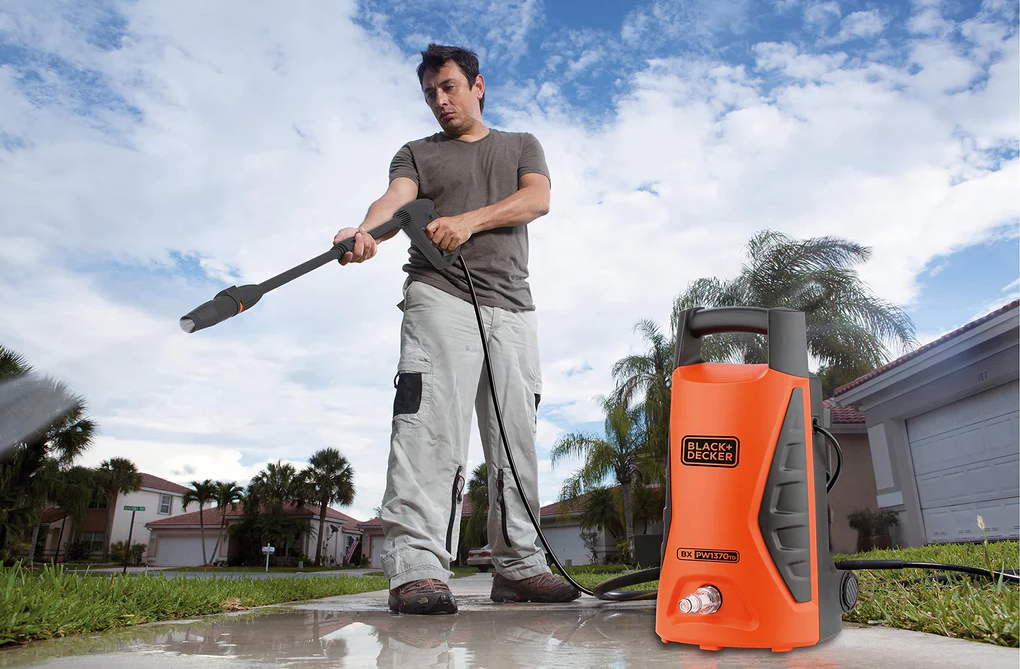
Content

Introduction Of Black+Decker Pressure Washer PW1370TD
The Black+Decker Pressure Washer is a powerful and versatile outdoor cleaning tool that makes quick work of dirty surfaces. With a max pressure of 1300 PSI and a flow rate of 1.2 GPM, this electric pressure washer is perfect for cleaning decks, patios, cars, and more. The Black+Decker Pressure Washer PW1370TD is easy to use, easy to store, and is a great value for the price. It was launched in 2021 and is now available for an estimated price of $150.
Detailed Specifications
- Max pressure: 1300 PSI
- Flow rate: 1.2 GPM
- Motor: 10 amp
- Hose length: 25 ft
- Cord length: 35 ft
- Weight: 23 lbs
- Onboard detergent tank: Yes
- Wheels: Yes
- Adjustable pressure: Yes
- Warranty: 2 years
Description of Pressure Washer PW1370TD
The Black+Decker Pressure Washer is designed to make outdoor cleaning easy and convenient. The electric motor is powerful enough to handle tough cleaning tasks, but quiet and easy to start. The adjustable pressure feature allows you to customize the pressure to the specific cleaning task at hand, and the onboard detergent tank makes it easy to add soap or detergent to the water. The 25-foot hose and 35-foot cord provide plenty of reach, and the wheels make it easy to move the pressure washer around. The PW1370TD comes with a variety of nozzles and accessories to handle different cleaning tasks, and it's easy to store when not in use.
Setup Guide
- Unpack the pressure washer and make sure all parts are included.
- Assemble the pressure washer by attaching the hose, wand, and nozzle.
- Plug in the pressure washer and add water to the tank.
- Add detergent to the onboard detergent tank if desired.
- Select the desired pressure setting and start cleaning.
GENERAL INFORMATION
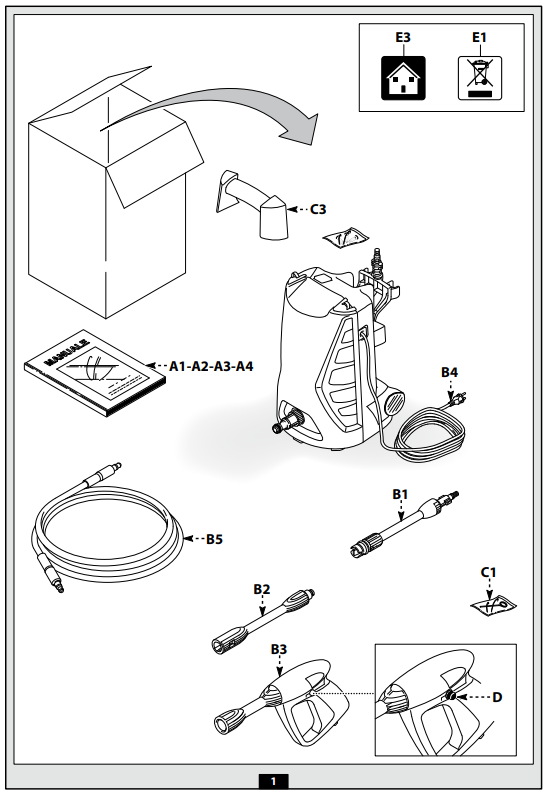
- Use of the manual
This manual forms an integral part of the appliance and should be kept for future reference. Please read it carefully before installing/using the unit. If the appliance is sold, the Seller must pass on this manual to the new owner along with the appliance - Delivery
The appliance is delivered partially assembled in a cardboard box. The supply package is illustrated in fig.1.- Documentation supplied with the appliance
- A1 Use and maintenance manual
- A2 Safety instructions
- A3 Declaration of Conformity
- A4 Warranty regulations
- Documentation supplied with the appliance
- Disposing of packaging
The packaging materials are not environmental pollutants but must still be recycled or disposed of in compliance with the relevant legislation in the country of use. - Safety signs
Comply with the instructions provided by the safety signs fitted to the appliance.
Check that they are present and legible; otherwise, fit replacements in the original positions.
E1 sign – Indicates that the appliance must not be disposed of as municipal waste; it may be handed into the dealer on purchase of a new appliance. The appliance's electrical and electronic parts must not be reused for improper uses since they contain substances that constitute health hazards.
Symbols- E2 symbol: Indicates that the appliance is intended for professional use, i.e. for experienced people informed about the relative technical, regulatory and legislative aspects and capable of performing the operations necessary for the use and maintenance of the appliance.
- E3 symbol: Indicates that the appliance is intended for non-professional (domestic) use.
TECHNICAL INFORMATION
- Envisaged use
This appliance has been designed for individual use for the cleaning of vehicles, machines, boats, masonry, etc, to remove stubborn dirt using clean water and biodegradable chemical detergents. Vehicle engines may be washed only if the dirty water is disposed of as per regulations in force.- Intake water temperature: see data plate on the appliance.
- Intake water pressure: min. 0,1MPa-max 1MPa.
- Operating ambient temperature: above 0°C.
The appliance is compliant with the EN 60335-2-79/A1 standard.
- Operator
The symbol on the front cover identifies the appliance’s intended operator (professional or non-professional). - Improper use
- Use by unskilled persons or those who have not read and understood the instructions in the manual is forbidden.
- The introduction of inflammable, explosive and toxic liquids into the appliance is prohibited.
- Use of the appliance in a potentially inflammable or explosive atmosphere is forbidden.
- The use of non-original spare parts and any other spare parts not specifically intended for the model in question is prohibited.
- All modifications to the appliance are prohibited. Any modifications made to the appliance shall render the Declaration of Conformity null and void and relieve the manufacturer of all liability under civil and criminal law.
- Main components
- B1 Adjustable spray nozzle
- B2 Lance
- B3 Gun with safety catch
- B4 Power supply cable with plug
- B5 High-pressure hose
- B6 Detergent tank (on models with this feature)
Accessories (if included in the supply package – see fig.1). - C1 Nozzle cleaning tool
- C2 Rotating nozzle kit
- C3 Handle
- C4 Brush
- C5 Hose reel
- Safety devices
Caution - Danger
Do not tamper with or adjust the safety valve setting.- Safety valve and/or pressure limiting valve.
The safety valve is also a pressure limiting valve.When the gun trigger is released, the valve opens and the water recirculates through the pump inlet or is discharged onto the ground. - Thermostat valve (D1 where fitted)
If the water temperature exceeds the temperature set by the manufacturer, the thermostat valve discharges the hot water and draws in an amount of cold water equal to the amount of water discharged, until the correct temperature is restored. - Safety catch (D): prevents accidental spraying of water.
- Safety valve and/or pressure limiting valve.
INSTALLATION
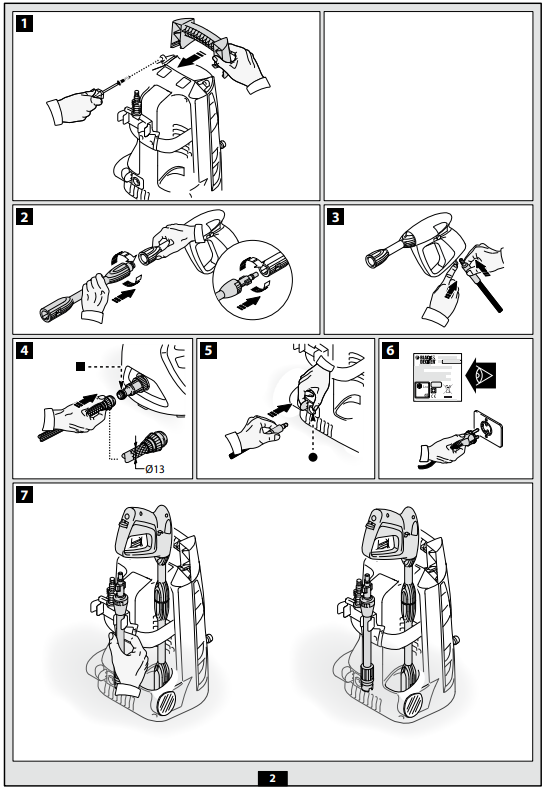
- Assembly
Caution - Danger!
All installation and assembly operations must be performed with the appliance disconnected from the main power supply. The assembly sequence is illustrated in Fig. 2. - Assembling the rotating nozzle
(For models with this feature) The rotating nozzle kit delivers greater washing power. Use of the rotating nozzle may cause of reduction in pressure of 25% compared to the pressure obtained with the adjustable nozzle. However, the rotating nozzle kit delivers greater washing power due to the rotation of the water jet. - Electrical connection
Caution - Danger
Check that the electrical supply voltage and frequency (V-Hz) correspond to those specified on the appliance data plate (fig.2). The appliance should only be connected to a mains power supply equipped with an adequate earth connection and a differential security breaker (30 mA) to cut off the electricity supply in the instance of a short circuit.- Use of extension cables
Use cables featuring the “IPX5” protection level. The cross-section of the extension cable should be proportionate to its length; the longer it is, the greater its cross-section should be. See table.
- Use of extension cables
- Water supply connection
Caution - Danger
Only clean or filtered water should be used for intake. The delivery of the water intake tap should be equal to that of the pump capacity. Place the appliance as close to the water supply system as possible.- Connection points
- Water outlet (OUTLET)
- Water inlet with filter (INLET)
- Connection to the mains water supply
The appliance can be connected directly to the mains drinking water supply only if the supply hose is fitted with a backflow preventer valve as per current regulations in force. Make sure that the hose is at least Ø 13 mm and that it is reinforced.
- Connection points
ADJUSTMENT INFORMATION
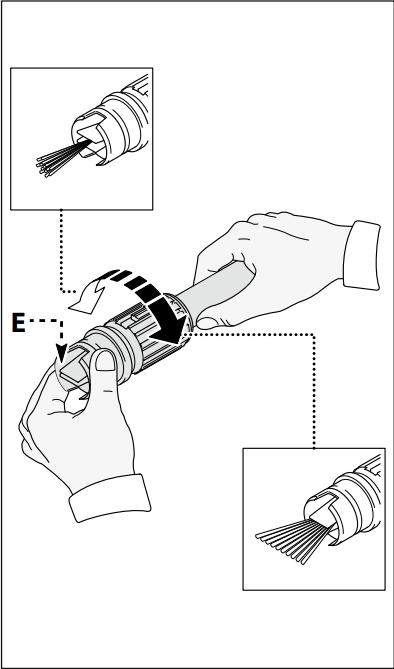
- Adjusting the spray nozzle (for models with this feature) Water flow is adjusted by regulating the nozzle (E).
- Adjusting the detergent (on models with this feature) Detergent flow is adjusted using the regulator (F).
- Adjusting the detergent pressure Set the adjustable nozzle (E) on "-" to deliver detergent at the correct pressure (on models with this feature)
- Adjusting the pressure (on models with this feature) The regulator (G) is used to adjust the working pressure. The pressure is shown on the pressure gauge (where fitted).
INFORMATION ON USE OF THE APPLIANCE
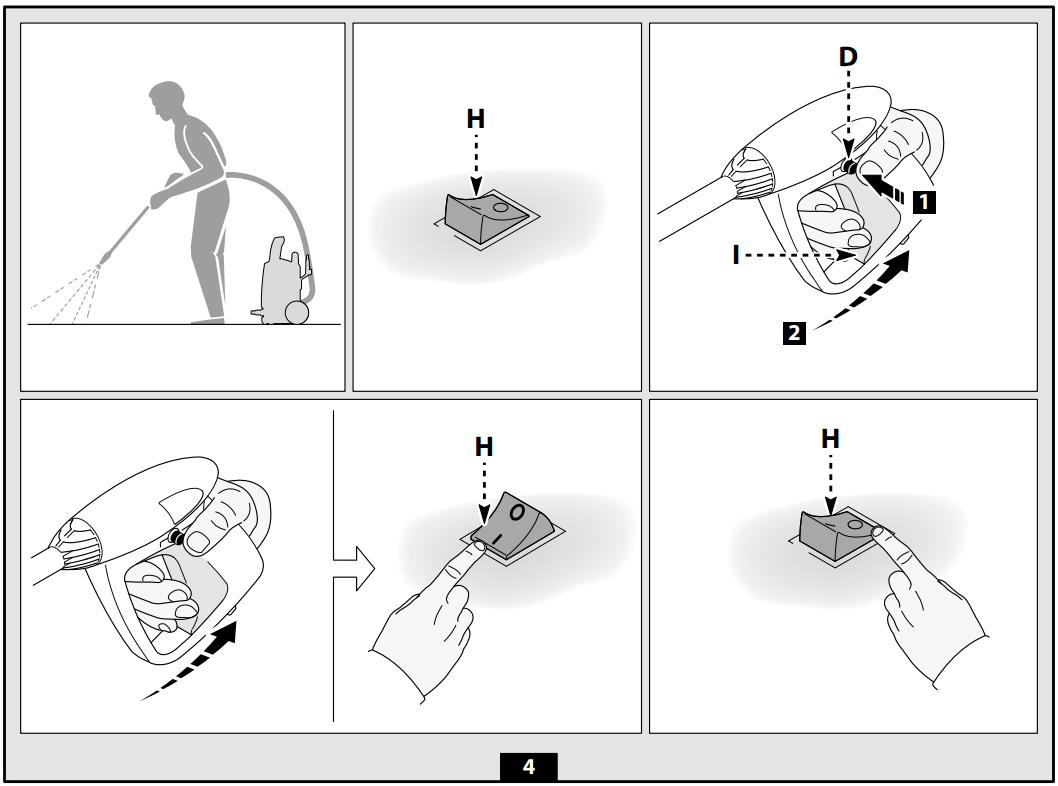
Controls
- S tarter device (H).
Set the starter switch on (ON/1) to- start the motor (in models without TSS device);
- set the motor ready to start (in models with TSS device). If there is a pilot light on the starter device, it should light up.
If the “low/high” settings are available, use them as follows - Low : low-pressure washing
- High : high-pressure washing
Set the starter device switch on (OFF/0) to shut down the appliance.
If there is a pilot light on the starter device, it should go out.
- Water jet control lever (I).
Caution - Danger
During operation, the appliance must be positioned as shown in Fig. 4 on a sturdy, stable surface.
Start-up
- T urn on the water supply tap fully.
- R elease the safety catch (D).
- Depress the gun trigger for a few seconds and start up the appliance using the starter device (ON/1).
Caution - Danger
Before starting up the appliance check that the water supply hose is connected properly; use of the appliance without water will damage it; do not cover the ventilation grilles when the appliance is in use.
TSS models
- In TSS models with automatic delivery flow cut-off system:
- when the gun trigger is released the dynamic pressure automatically cuts out the motor (see fig.4);
- when the gun trigger is depressed the automatic drop in pressure starts the motor and the pressure is restored after a very slight delay;
- if the TSS is to function correctly all gun releasing and depressing operations must be performed at intervals of less than 4-5 seconds.
On three-phase models for professional use, at first use start the appliance for a very short time to check that the motor is running in the correct direction. If the motor fan is turning anti-clockwise, exchange two of the three-phase wires (L1, L2, L3) in the electrical plug. To prevent damage to the appliance, do not allow it to operate dry and when running do not stop the water jet for more than 10 minutes at a time (for models without TSS device).
Stopping the appliance
- S et the starter device switch on (OFF/0).
- Depress the gun trigger and discharge the residual pressure inside the hoses.
- E ngage the gun safety catch (D).
Restarting
- R elease the safety catch (D).
- Depress the gun trigger and discharge the residual air inside the hoses.
- S et the starter device on (ON/1).
Storage
- S witch the appliance off (OFF/0).
- R emove the plug from the socket.
- T urn off the water supply tap.
- Discharge the residual pressure from the gun until all the water has come out of the nozzle.
- Drain and wash out the detergent tank at the end of the working session. To wash out the tank, use clean water instead of the detergent.
- E ngage the gun safety catch (D).
Refilling and using detergent
When using detergent, the adjustable nozzle must be set on "-" (on models with this feature). Use of a high pressure hose longer than the one originally supplied with the cleaner, or the use of an additional hose extension, may reduce or completely halt the intake of detergent. Fill the tank with highly degradable detergent.
Recommended cleaning procedure
- Dissolve dirt by applying the detergent mixed with water to the surface while still dry.
- When dealing with vertical surfaces work from the bottom upwards. Leave the detergent to act for 1-2 minutes but do not allow the surface to dry. Starting from the bottom, use the high pressure jet at a minimum distance of 30 cm. Do not allow the rinse water to run onto unwashed surfaces.
- In some cases, scrubbing with brushes is needed to remove dirt.
- High pressure is not always the best solution for good washing results, since it may damage some surfaces. The finest adjustable nozzle jet setting or the rotating nozzle should not be used on delicate or painted parts, or on pressurised components (e.g tyres, inflation valves, etc.).
- Effective washing depends on both the pressure and volume of the water used, to the same degree.
MAINTENANCE
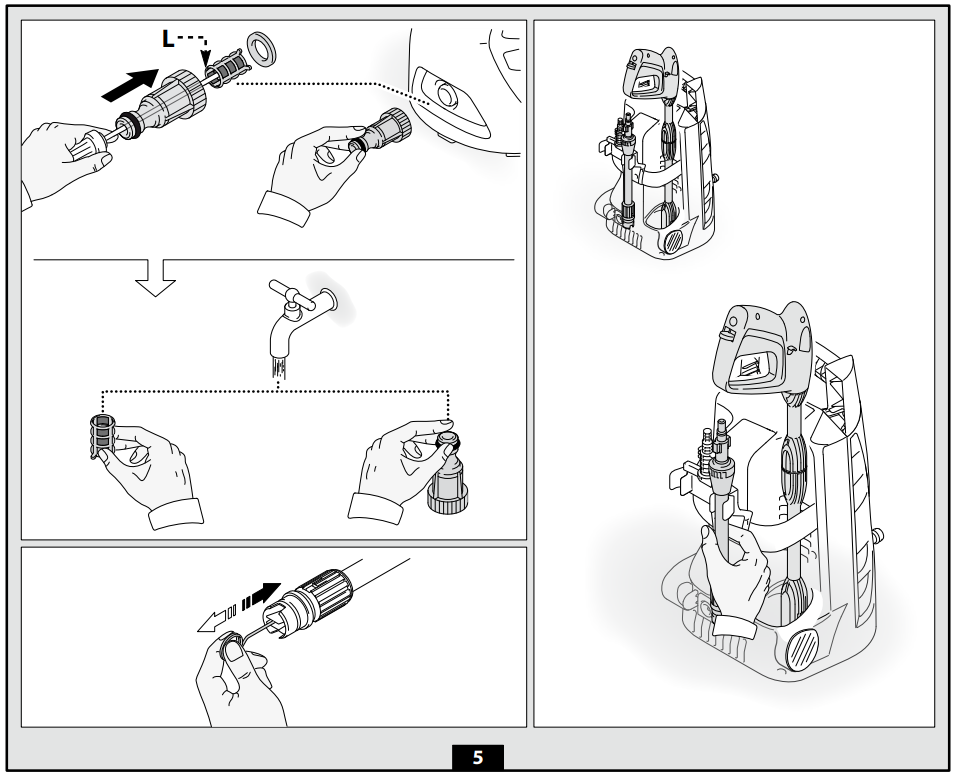
Any maintenance operations not covered by this chapter should be carried out by an Authorized Sales and Service Centre.
Caution - Danger
Always disconnect the plug from the power socket before carrying out any work on the appliance.
- Cleaning the nozzle
- Disconnect the lance from the nozzle.
- Remove any dirt deposits from the nozzle hole using the tool (C1).
- Cleaning the filter
Inspect the intake filter (L) and detergent filter (if fitted) before each use, and clean in accordance with the instructions if necessary. - Unjamming the motor (on models with this feature)
In case of lengthy stoppages, limescale sediments may cause the motor to seize. To unjam the motor, turn the drive shaft with a tool (M). - End-of-season storage
Treat the appliance with non-corrosive, non-toxic antifreeze before storing it away for winter. Put the appliance in a dry place, protected from frost.
TROUBLESHOOTING
Problem | Possible causes | Remedy | ||
Pump does not reach working pressure | Nozzle worn | replace nozzle | ||
Water filter fouled | Clean filter (fig.5) | |||
Water supply pressure low | turn on water supplygun trigger tap fully | |||
air being suckedinto system | Check tightness of hose fittings | |||
air in pump | switch off the appliance and keep depressing and releas- ing the guntrigger until the water comes out in a steady flow. switch the appliance back on again. | |||
adjustable nozzle notpositioned correctly | turn the adjustable nozzle (E) (+) (fig.3) | |||
thermostatic valve tripped | Wait for correct water temperature to be restored | |||
Pressure drops during use | Water intake from external tank | Connect appliance to the mains water supply | ||
intake water too hot | reduce temperature | |||
Nozzle clogged | Clean nozzle (fig.5) | |||
intake filter (L) dirty | Clean filter (L) (fig.5) | |||
Motor “sounds” but fails to start | insufficient power supply | Check that the voltage of the mains power supply lineis the same as that on the plate(fig.2) | ||
Voltage loss due to use of extension cable | Check characteristics of extension cable authorized-main seal socket and replaced | |||
appliance not usedfor a longperiod of time | Contact your nearest authorized-mains power service Centre | |||
Problems with tss device | Contact your nearest authorized service Centre | |||
Motor fails to start | No electrical power | Check that the plug is firmly in the socket and that the mains voltage supply is present (*) | ||
Problems with tss device | Contact your nearest authorized service Centre | |||
appliance notused for a long periodof time | using the tool(L) unjamthe motor fromthe hole at the rear of the appliance(in models with this feature) (fig.5) | |||
Water leakage | seals worn | have the sealsreplaced at your nearest authorized service Centre | ||
safety valve tripped and discharging | Contact an authorized service Centre | |||
appliance noisy | Water too hot | reduce temperature (see technical data | ||
Oil leakage | seals worn | Contact your nearest authorized unjam the service Centre | ||
TSS versions only:motor starts even withgun trigger is released | Nozzle clogged | Clean nozzle (fig.5) | ||
high pressure systemor pump hydraulic circuit not watertight | Contact your nearest authorized service Centre | |||
TSS versions only: no waterdeliv- ery when guntrigger is depressed (with supply connected) |
Nozzle clogged |
Clean nozzle (fig.5) | ||
No detergent taken in | adjustable nozzle on high pressure setting | set nozzle on " | _ | " setting (fig.5) |
Detergent too dense | Dilute with water | |||
high pressure hose extension being used | Fit original hose | |||
Deposits or restriction in detergent circuit | Flush with clean water and eliminate any restrictions. if the problem persists, contact an authorized service Centre | |||
Technical Data
| Technical Data | Unit | PW1370 |
|---|---|---|
| Output | L/min | 6 |
| Pressure | MPa | 7 |
| Maximum pressure | MPa | 10 |
| Power | kW | 1.3 |
| Temperature input | °C | 50 |
| Maximum input pressure | MPa | 1 |
| Repulsive force of the gun to the maximum pressure | N | 9.1 |
| Motor Insulation | Class F | |
| Motor Protection | IPX5 | |
| Voltage | V/Hz | 220-240/50-60 |
| Sound level (K=3 dB(A)) : | ||
| Lpa (EN 60704-1) | Db (A) | 75.1 |
| Lwa (EN 60704-1) | Db (A) | 83 |
| Unit vibrations (K=1.5M/s²) | M/s² | 2.74 |
| Weight | kg | 5.6 |
Pros & Cons of Black+Decker Pressure Washer
Pros
- Powerful motor with adjustable pressure
- Onboard detergent tank
- Long hose and cord
- Lightweight and easy to manoeuvre
- Easy to store
Cons
- Not suitable for heavy-duty cleaning tasks
- Some users have reported issues with the durability of the hose and wand
Customer Reviews about Black+Decker Pressure Washer PW1370TD
Customers generally have positive things to say about the Black+Decker Pressure Washer . They appreciate its power, versatility, and ease of use. Many users have commented on how much time and effort the PW1370TD has saved them when cleaning their decks and patios. However, some users have reported issues with the durability of the hose and wand, and a few have noted that the pressure washer is not suitable for heavy-duty cleaning tasks.
Faqs
I have a Black+Decker Pressure Washer PW1370TD pressure washer; what is the first step in the process of setting it up?
If my Black+Decker Pressure Washer PW1370TD is not turning on, what steps should I take to fix the problem?
When it comes to drawing water from a static source, such as a bucket, is the Black+Decker Pressure Washer PW1370TD capable of doing so?
WEhat kind of maintenance is required for the Black+Decker Pressure Washer PW1370TD ?
During the time that I am using the Black+Decker Pressure Washer PW1370TD , what safety precautions should I practise?
Regarding the Black+Decker Pressure Washer, is it possible to use detergents with Black+Decker Pressure Washer PW1370TD ?
In the event that the Black+Decker Pressure Washer PW1370TD is operating but there is no water being expelled, what should I do?
When the pressure washer is not being used, what is the best way to keep it?
With the many nozzles that are given, what are the proper applications for each one?
How long is the warranty period for the Black+Decker PW1370TD?
Leave a Comment
